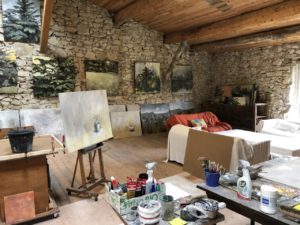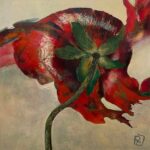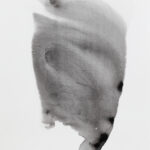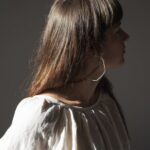BRIGITTE DYKMAN – “Painting is the spice of my life, my private corner, my secret garden that I nevertheless long to share with others”

 I first met Brigitte Dykman many years ago at her studio. I had been told that she was the co-founder of an association called “l’Art à demeure” the aim of which was to further the work of visual artists living and working in the Drôme. Within a short time owing to her efforts and the dedication of an enthusiastic team of volunteers it had acquired widespread recognition among art lovers throughout our region. Its activities lasted ten years during which it came to be regarded as a showcase for the work of its many members who greatly benefitted from a variety of promotional activities such as visits to artists’ studios, sculpture exhibitions in gardens, mapping out of art routes, etc. Sponsors, as well as the local authorities where the events were held, backed the association and the press and the media covered them extensively. All this made me want to meet Brigitte who was a driving force behind “l‘Art à demeure” as well as being a very good artist in her own right.
I first met Brigitte Dykman many years ago at her studio. I had been told that she was the co-founder of an association called “l’Art à demeure” the aim of which was to further the work of visual artists living and working in the Drôme. Within a short time owing to her efforts and the dedication of an enthusiastic team of volunteers it had acquired widespread recognition among art lovers throughout our region. Its activities lasted ten years during which it came to be regarded as a showcase for the work of its many members who greatly benefitted from a variety of promotional activities such as visits to artists’ studios, sculpture exhibitions in gardens, mapping out of art routes, etc. Sponsors, as well as the local authorities where the events were held, backed the association and the press and the media covered them extensively. All this made me want to meet Brigitte who was a driving force behind “l‘Art à demeure” as well as being a very good artist in her own right.
She greeted me warmly and I clearly remember entering into a large studio buzzing with activity. In one corner a few pupils worked at their paintings and in another three or four women were holding a meeting. Brigitte introduced me to them. They were busy preparing the next event on “l’Art à demeure’s” agenda and as there were still one or two items to be dealt with Brigitte suggested I look around her studio where some of her paintings were exhibited until she tied up the meeting.
 The paintings immediately caught my eye for they were very different from the pale imitations of works by well-known artists one far too often comes across in art galleries. The palette she used was made up of tawny earth colours and it was limited. Some represented a simple bowl whereas others reflected the diffused lighting in a space that might have been a cave or an empty room. I sensed that the artist had sought to express the “idea” of the subjects she had chosen to render rather than their outward appearance. Although they had been painted in a different period of time, the colour scheme, the balanced composition and the focus on a similar theme reminded me of some of the Italian painters of the interbellum I love like Filippo de Pisis, Carlos Carrà and of course Giorgio Morandi. For a while after that first meeting, we lost touch. Brigitte was involved with Philippe Mussy, an enlightened contemporary art lover, in yet another artistic adventure that lasted for nine years. “La Grande Galerie” was a unique art centre established in an old silk factory in the Drôme in which successful exhibitions were organised of works by top ranking artists both from France and abroad. Meeting and exhibiting with them proved to be an extremely enriching experience for Brigitte and it also satisfied, she said, her deep-rooted need to cooperate and exchange ideas with other artists.
The paintings immediately caught my eye for they were very different from the pale imitations of works by well-known artists one far too often comes across in art galleries. The palette she used was made up of tawny earth colours and it was limited. Some represented a simple bowl whereas others reflected the diffused lighting in a space that might have been a cave or an empty room. I sensed that the artist had sought to express the “idea” of the subjects she had chosen to render rather than their outward appearance. Although they had been painted in a different period of time, the colour scheme, the balanced composition and the focus on a similar theme reminded me of some of the Italian painters of the interbellum I love like Filippo de Pisis, Carlos Carrà and of course Giorgio Morandi. For a while after that first meeting, we lost touch. Brigitte was involved with Philippe Mussy, an enlightened contemporary art lover, in yet another artistic adventure that lasted for nine years. “La Grande Galerie” was a unique art centre established in an old silk factory in the Drôme in which successful exhibitions were organised of works by top ranking artists both from France and abroad. Meeting and exhibiting with them proved to be an extremely enriching experience for Brigitte and it also satisfied, she said, her deep-rooted need to cooperate and exchange ideas with other artists.
Brigitte’s professional career has been a full one that deserves to be told. These are some of her answers to my questions.
Did you grow up in an environment that was open to art and were there any signs in your childhood that you might one day become an artist?
 “Not really. My family appreciated art like many families do, but not more than that. My sister though, was a talented dancer and in the family, she was the one who was considered to be the artist. As a child I preferred outdoor activities, in fact I was quite a tomboy and not the sort of little girl who loved playing with dolls. My interest in art really began at secondary school when I chose to follow the literature programme which included drawing and art history classes.”
“Not really. My family appreciated art like many families do, but not more than that. My sister though, was a talented dancer and in the family, she was the one who was considered to be the artist. As a child I preferred outdoor activities, in fact I was quite a tomboy and not the sort of little girl who loved playing with dolls. My interest in art really began at secondary school when I chose to follow the literature programme which included drawing and art history classes.”
When did you decide that you wanted to become an artist?
 Having obtained my high school diploma and considering my growing interest in art I decided to pursue my studies at the Faculty of Fine Arts that had been established a short while before by the Paris University.”
Having obtained my high school diploma and considering my growing interest in art I decided to pursue my studies at the Faculty of Fine Arts that had been established a short while before by the Paris University.”
You are a figurative artist although it could be argued that there is a form of abstraction in your paintings for they are not copies but aim at conveying emotions which are per definition abstract and elusive feelings. When they look back many artists of your generation say that they felt frustrated during their studies because it was a time when conceptual art was favoured, and representational art considered as something from the past. What was your experience?
“My first steps at the Faculty were disappointing. The programme was still being developed and there were many loopholes. It comprised courses in art history, architecture, sculpture, chromatics and engraving but there were no drawing classes. I decided to fill in some of the gaps by attending drawing classes at the Ecole d’Arts Appliqués, a school of applied art in Paris. Drawing has been and will always remain the basis of my painting.”
When and how did your professional life as an artist begin?

“After my studies I married, and we had children and so I spent much of my time attending to their education. I did however continue to paint either on my own or along with other artists. In 1976 I joined and actively participated in an artist’s association. There must be something in my nature that makes me want to cooperate with others and learn from their experience, which in turn probably explains why I have so frequently been involved in art-related projects. My husband was posted to a number of different places in France and on two occasions abroad – to Australia and Cameroun – and each time I found ways to give lessons in art in order to pursue my activity as a painter. During this nomadic period of my life that lasted for twenty years I made heaps of watercolours, a medium I practiced with passion. I never ceased showing my work both in France and abroad and I have continued to do so since coming to the Drôme in 1996. “
Let’s talk about your work and the subjects close to your heart…
 “I mainly work in acrylics and if required I use mixed techniques. As I have already mentioned I am a figurative painter and although I apply myself to making precise drawings I am not overly concerned in making exact reproductions of my subjects but by the feeling that emanates from them. My quest for an emotion leads me to constantly go back over a drawing and take time to carefully observe and scrutinise it while I proceed. I always work with a great economy of means so as not to be tempted by the tendency to be decorative or to fall prey to the prettiness of an excess of colour. All I need are a few painting tubes, poor quality brushes, and utensils deviated from their original purpose like a mason’s squeegee. I also like to paint on rough surfaces like cardboard or wood as they offer a form of resistance that I have come to appreciate over the years because it forces me to pay more attention to what I am doing and because as the ground is uneven you can sometimes obtain surprising effects.“
“I mainly work in acrylics and if required I use mixed techniques. As I have already mentioned I am a figurative painter and although I apply myself to making precise drawings I am not overly concerned in making exact reproductions of my subjects but by the feeling that emanates from them. My quest for an emotion leads me to constantly go back over a drawing and take time to carefully observe and scrutinise it while I proceed. I always work with a great economy of means so as not to be tempted by the tendency to be decorative or to fall prey to the prettiness of an excess of colour. All I need are a few painting tubes, poor quality brushes, and utensils deviated from their original purpose like a mason’s squeegee. I also like to paint on rough surfaces like cardboard or wood as they offer a form of resistance that I have come to appreciate over the years because it forces me to pay more attention to what I am doing and because as the ground is uneven you can sometimes obtain surprising effects.“
What are your favourite subjects?
“Broadly speaking I am fascinated by the plant and mineral worlds, and light, and I want to capture their different aspects in my paintings. I can constantly go on painting the same tree, a bunch of grapes or a single thistle to satisfy my curiosity and attempt to get to the bottom of their deeper significance for me. This quest also applies to objects that are part of my immediate surroundings because they are familiar and they reassure me.”


What is the significance of art for you? Or put differently, just imagine that for one reason or another you were permanently prevented from making works of art, what would that do to you?
My answer will be a personal one for I don’t feel entitled to make global statements on art. However, it is easier to answer the second part of your question.

Painting is the spice of my life, my private corner, my secret garden that I nevertheless long to share with others. As I have already mentioned I like painting ordinary subjects in the quiet atmosphere of my studio. I try to turn them into something unique through the alchemy of matter, colour, light and graphics. Canvas is the playground on which I match myself against colour, texture, the line and the point to reveal the exceptional character, the uniqueness of an “object” or for instance of a “field of sunflowers.” To be witness to how the subject changes as I stop to consider it and hesitate and make eventual corrections is a source of deep visual and personal satisfaction. Adding the last touch to a painting and believing that I have created something that has never existed….is simply exhilarating!
What if I were prevented from painting? I would turn this brightly coloured period and look to the future? Of course, I would think back on all these years spent painting in the isolation of my studio with a feeling of great tenderness but without regret, in order to focus on what is coming next. Painting is VERY IMPORTANT to me, but it has never occupied the whole space of my life in which there are so many other reasons to be happy
Posted in: Art


